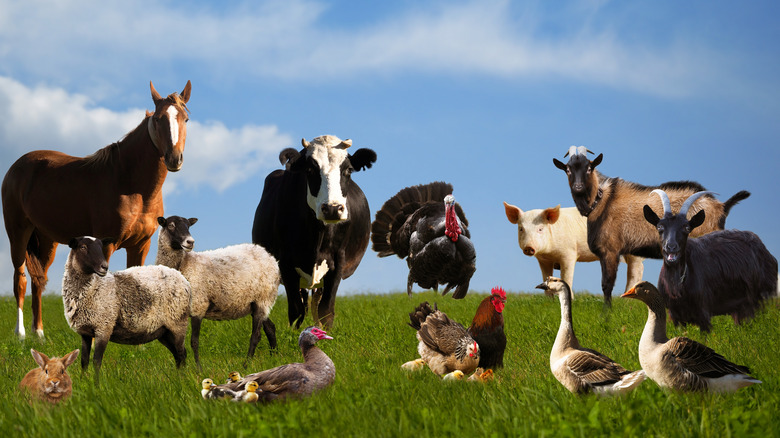What Does Human Flesh Taste Like?
ScienceAlert calls it "the ultimate taboo," and here "it" means cannibalism. Multiple species in the animal kingdom eat their own, including their young, for a variety of reasons (including infection control or simply for nourishment). Some mammals, including rodents, also do it. Even chimpanzees, our closest evolutionary cousins, are known to cannibalize each other on rare occasions (and they don't generally eat much meat!). But for humans, cannibalism is taboo in the extreme. Pretty much all cultures eschew it, according to National Geographic, although the practice has existed historically and still goes on in some remote corners of the world. And in at least one case — that of a brain disease in Papua New Guinea — human cannibalism played a role in its spread.
In societies where cannibalism remains taboo, when it's been practiced, it's almost always been the result of criminality — a murderer who eats his victims, for example, or from desperation when facing starvation, as was the case for the Donner Party. Considering the extreme taboo surrounding the practice, the matter of what human flesh tastes like remains somewhat mysterious. As it turns out, a few anecdotal reports have emerged over the centuries describing how human meat strikes the palate.
The Spam/'Long Pig' Urban Legend
Before getting into the science of the taste of human flesh (and yes, there's been some science on it), we're going to deconstruct an urban legend about it that's been going around for a few decades. Back in 1998, Chicago Reader columnist Cecil Adams, writing in the "Straight Dope" column, tackled the urban legend of Spam (the canned meat product, not the email scourge), cannibalism, and Pacific Islander culture. Specifically, Adams addressed a legend that states that Spam is popular in the Pacific islands because it tastes like "long pig," where "long pig" is a euphemism for human flesh (human flesh tastes like pork, and humans are long, get it?). It's not true: Spam is popular in the region for a number of reasons, perhaps the biggest of which is that Spam has a long shelf life, and the tropical regions of the South Pacific aren't conducive to long-term meat storage. For another, much of the Polynesian diet is based on pork (small pig, as it were), and Spam is made of pork. And as regards cannibalism, while it certainly went on in the Pacific islands, Christianity has been there for centuries, and as Adams points out, the arrival of Christianity to the region pretty much put an end to the practice.
"Does Spam taste corpsy? Of course it tastes corpsy–it's meat. We're just arguing about the identity of the deceased," says Adams.
Maybe It Tastes Like Beef, Or Maybe Veal
There are several problems with describing the taste of meat, not the least of which is that taste is entirely subjective. Then there's the fact that the tastes of meat are subtle and depend largely on their preparation — smoking vs. frying, for example, or which seasonings (if any) are added, whether or not it was marinated or brined, and so on.
Nevertheless, a few people have eaten human flesh and written it down. As Slate reports, back in the 1930s, American adventurer and journalist William Buehler Seabrook lived amongst cannibals in Africa for a while and noted that when raw, human flesh resembles beef. When cooked, it turned grayish, a la lamb or veal. His cannibal hosts wouldn't allow him to eat any human flesh, but not wanting to miss out, according to Smithsonian Magazine, he got some human flesh from a hospital (we're not going to look into how) and cooked it up himself. He described it as tasting like veal, to the point that the two are indistinguishable.
Of course, Seabrook wasn't the only person to have eaten human flesh and either written it down or been asked about it later. "Both serial killers and Polynesian cannibals have described human as being most akin to pork," according to Smithsonian Magazine. Still, it goes without saying that recipes for human flesh are going to be elusive, so the matter of what it tastes like seasoned, brined, marinated, or so on will have to be left to the imagination.
The BBC Earth Lab Experiment
You've heard of Gonzo journalism, where the writer is himself/herself a part of the story? We're now going to introduce you to an adjacent concept: Gonzo science, where the scientist is himself a part of the experiment. What does this have to do with cannibalism? A few years ago, BBC Earth Lab did an experiment wherein a man named Greg Foot (we're not kidding) endured a biopsy. A small piece of muscle from his leg was removed, under the controlled medical conditions of a British clinic, so that it could be evaluated for taste. The entire event can be seen here via YouTube, but we're going to warn you now that it may turn your stomach.
The surgeon produced a few small samples, each smaller than a dime. "It's about half the same type of muscle found in chicken breast," Foot noted, adding that it contains muscle fibers similar to those in beef. Foot didn't eat his own meat, as that's illegal in Britain, even if it's your own. Instead, he did the next best thing and went to a lab, which analyzed the aromas put off by the cooked samples. The scientist who did the analysis concluded that it's "a bit toward the lamb and the pork."
Foot didn't eat himself. Instead, he bought some actual lamb and pork, minced it together, cooked it up into a hamburger, and ate it. "It's pretty good," he said, smiling at the camera.



